Details
-
Alex Carroll

- Heart Shaped Stones

- Heart Shaped Stone Pendants

- Heart Stone Frames

- Sea Glass

- The “Crown Jewel of the Sea” Timepiece

- Charity Auction

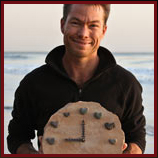 Alex Carroll
Alex Carroll
Alex Carroll started his first business when he was 8 years old.
He designed and handcrafted beautiful strings of spinning wind decorations out of aluminum cans … and then personally sold them door-to-door in residential neighborhoods.
People loved them … and he ended up selling thousands of them. But his parent’s divorce, school, life and a successful career in the publishing and PR business intervened and sent him in many other directions for many years.
And to a great degree, his creative passions got pushed to the side as well.
But they never died.
Alex always had a great love of the beach and the ocean, and everywhere in the world he traveled, he would always find his way to the seashore.
A decade or so ago he started collecting the occasional heart shaped stone that he would find washed up on the shore. He never had any plans to do anything with them … he just liked collecting them because they were beautiful, rare, unusual … and he loved what they symbolized. And it gave him another excuse to spend more time at his favorite place … the beach!
The seed for all of the Heart Stones creations you see now, sprouted a few years ago when Alex was looking for a nice wall clock. He wanted something natural and organic … but classy as well. And no matter how hard he tried, he just couldn’t find what he was looking for. So he eventually decided to just make it himself. It was at that point (as he was pondering what he wanted to make his clock out of) that it occurred to him, “Why not make it using some of these heart shaped beach stones I’ve been collecting?”
And thus the “Heart Rock Clock” was born.
Everyone who saw it … loved it … and wanted one.
And it didn’t take Alex long to realize that maybe he should make more of them.
He counted up all his heart stones for the first time … and found that he had well over a thousand of them … or enough to make 100 clocks.
So he decided to make a special limited edition series of 100 clocks.
And as his creative juices reawakened along the way, he also decided to make heart stone pendants and picture frames as well … not to mention what could be the world’s rarest timepiece out of a 20 million year old piece of naturally heart shaped fossilized Bali Star Coral and an incredibly rare collection of naturally heart shaped pieces of red sea glass (the most sought-after color).
Suffice it to say, Alex is happy to have finally returned to his roots and be creating beautiful treasures once again.
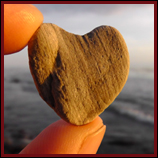 Heart Shaped Stones
Heart Shaped Stones
While it is possible to find naturally heart shaped stones other places in nature, nowhere are they more smooth and rounded than when they are tumbled and polished by the ocean and washed up on the seashore.
It is for this reason (and the fact that he just loves the beach and the ocean) that Alex collects all of his heart shaped stones from the seashore.
He never alters them in any way and always leaves them in exactly the state he finds them.
He is also very selective about the pieces he chooses to keep.
The most important factor in determining whether he will keep a piece or not … is symmetry. He looks for pieces that are equally proportioned on both sides … and whose bottom point is in a straight line vertical axis with its cleft at the top.
If a piece is either off balance to one side or the other … or not in alignment vertically, Alex generally rejects it.
Other factors involved in the selection process include size, weight, color, and type of stone.
In general Alex looks for heart stones that are between ¾ “ and 1 ½” across (20-40mm) and that weigh under an ounce (30 grams) … preferably somewhere around a half an ounce (15 grams).
This is not to say that if Alex finds a big heart stone he won’t keep it. The largest heart stone in his collection is actually a red one that measures nearly 2 feet across (60cm) and weighs almost 100 pounds (45 kilograms)
He might also choose to keep a piece if it’s slightly off center … but happens to be a rare color like red or blue.
Occasionally Alex finds very nicely shaped and aligned pieces that are made of unstable types of rock … like shale. Even though their shape may be excellent, he normally rejects them because they have a tendency to deteriorate and crumble over time.
As difficult to believe as it sounds, on average, Alex will scan a million rocks before he finds ONE really good heart shaped stone that meets all of his criteria. So they are actually quite a rare phenomena … and not very easy to find at all.
He generally reserves these exceptional specimens for premium pendants … but he also used a significant number of them in the creation of his first 10 premium clocks.
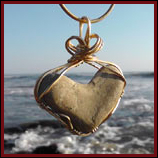 Heart Shaped Stone Pendants
Heart Shaped Stone Pendants
Believe it or not, out of all of Alex Carroll’s heart stone creations, the pendants are his favorite. Their elegance, beauty, simplicity and most of all … magic … are unparalleled by anything you have ever beheld. They will literally take your breath away.
When people see and hold one in person for the first time … their reactions are often nothing short of euphoric.
And that’s just the beginning.
The real magic begins when you put one on … and place it above your heart.
There is something indescribable that happens when you have a heart stone … made by nature and birthed by the ocean … softly murmuring into your heart.
It is something that must be felt to be appreciated … something that will penetrate to the very core of your being.
Each pendant is lovingly gold or silver wire wrapped by hand. No machine ever comes anywhere near them. And because every stone is different, so is each mounting.
No two heart stone pendants are the same … and no two ever will be.
Alex decides whether the heart stone will be set in either gold or silver based on the color of the stone. In general, if the stone is in the earth tone family of colors, Alex will set it in gold … and if it is in the black, white or blue color range, he will set it in silver.
Crowning the top of each pendant is an elegant, swirling, dancing heart shaped bale by which the heart stone is suspended from the chain.
At the top of the chain, attached to the clasp ring, is a tiny gold or silver tag engraved with the number of the pendant nested inside of the Heart Stones logo on one side … and Alex’s signature and the date on the other.
 Heart Stone Frames
Heart Stone Frames
Alex Carroll’s hand-hewn solid sandstone picture frames are like no photo frame you’ve ever seen before.
If you ask someone what they would save first if their house were on fire … most people won’t hesitate to say their photographs (after their pets and loved ones of course).
Photographs are incredibly precious and valuable to most people.
Why?
Because they capture and preserve priceless, irreplaceable memories.
So why would anyone want to cradle something so valuable and so precious … in a cheap, mass produced frame?
That was the question Alex asked himself.
And the answer was … “They wouldn’t.”
And yet few people would argue that the vast majority of picture frames available are either tacky … or gaudy … or both.
So just as he did with his timepieces, Alex set out to create something beautiful … something natural … something stunning.
And nothing has as much natural beauty and class as solid stone.
One of the first things you notice about Alex’s frames … is the sheer weight of them.
Each frame is hewn by hand out of a solid piece of sandstone and retains a rough edged organic look and feel to it.
The opening for the photograph is then cut out by a waterjet that slices through the stone with unbelievable precision at an incredible 90,000 PSI … and the ledge for the glass and backing is then routered out by hand.
There are no seams or joints. Each frame is one unbroken piece of solid stone.
Alex then decides whether the frame will be oriented vertically (often used for wedding photos as the couple is usually standing) or horizontally (often used for families as they are often seated together and spread out) and then epoxies the appropriate number (one for each person in the photo) of naturally heart shaped stones to the bottom of the frame … just below the photograph.
The couple’s photos obviously have two heart stones at the bottom, and the family photos will have 3 or more … depending on the size of the family. If you wish, more heart stones can be added to the frame later as your family grows.
Each “Heart Stone” picture frame is custom made by hand and signed and numbered with an engraved plaque on the back.
For those who truly cherish their memories with their loved ones … these are the ultimate photo frames.
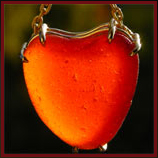 Sea Glass
Sea Glass
Sea glass (also known as “Beach Glass”) comes from actual shards of glass that have found their way into the ocean and been naturally tumbled and frosted by the wave and tidal action over a period of many years … and then washed back up on shore.
Many pieces have literally been tumbled by the ocean for centuries before they wash back up on shore.
The more frosted and rounded a piece of sea glass is … the longer it has been out in the ocean.
Alex loved the texture and color of sea glass … and began saving the occasional heart shaped piece that he would come across while searching for heart shaped stones.
Sea glass can be found in every color of the rainbow … but some colors are much rarer and harder to find than others.
The most common colors are “white” or opaque (from clear glass), brown and green.
Rarer colors include blues, aquas, pinks, purples, and grays.
The rarest colors include yellows, oranges and especially reds.
In over a decade of collecting, Alex has yet to personally find a single piece of red sea glass … of any size or shape.
The North American Sea Glass Association (NASGA) estimates that the average sea glass collector will find a piece of red sea glass at the rate of about 1 in every 5,000 pieces they pick up … so Alex is probably due to find one soon.
There are tens of thousands of sea glass collectors around the world and NASGA’s annual festival attracts thousands of visitors.
Each of the specimens in Alex’s priceless collection of naturally heart shaped pieces of red sea glass have all been acquired from other collectors over the years.
Sea glass is becoming rarer with each passing year as more and more collectors appear. The supply has also dwindled dramatically in recent years due to plastics replacing glass and the drastic reduction of ocean dumping that was once common around the industrialized world.
As the demand for sea glass has grown and the supply dwindled, “fake” or “artificially-made” sea glass has begun to enter the marketplace. “Fake” or “artificially made” sea glass can be created either in a rock tumbler or through a chemical glass etching process.
It is not the same however … and the trained observer can easily tell the difference.
Authentic “ocean-made” sea glass is impossible to duplicate, and just like cubic zirconias will never be real diamonds, “fake” sea glass will never be the real thing.
Each one of the pieces in Alex’s collection of red heart shaped sea glass have been personally examined and certified as authentic pieces of naturally ocean made sea glass by the president and founder of NASGA, Richard LaMotte, who is considered to be the world’s foremost expert on sea glass.
Alex’s collection of 18 pieces of naturally heart shaped red sea glass is the largest of its kind in the world.
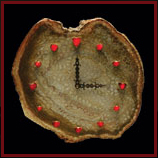
The “Crown Jewel of the Sea” Timepiece
The story of the “Crown Jewel of the Sea” timepiece, and the heart shaped piece of fossil coral from which it is made, is so unlikely … that it’s almost unbelievable. Even Alex, who lived it, still has a hard time believing that it actually happened. And when it did … he KNEW that this piece was something BEYOND special.
The story really began when Alex first discovered that naturally heart shaped pieces of red sea glass actually existed.
It was in that moment that he thought … “Wow, if I could manage to find 12 of these … I would really love to make a beautiful timepiece with them.”
In the beginning he wasn’t sure if it was even going to be possible … because they were THAT rare.
But after a couple of years of scouring the globe and networking amongst the sea glass collector community … he achieved what at one point had seemed impossible … he had managed to acquire enough pieces to make a clock. In fact he had managed to acquire the world’s largest collection … 18 pieces altogether.
It was at that point that he thought and asked himself, “Well, these red sea glass hearts are incredibly rare and special, so I need to find something equally rare and special to make the face of the clock with. What on earth could that be?”
His first thought was that whatever it was … it should come from the sea … just like the sea glass. A friend asked if he had ever seen fossilized coral and suggested that it might be a possibility.
Alex looked into it, and found that there were several kinds, and each of them presented various challenges.
The most common type of fossil coral can actually be found in plentiful amounts in the state of Michigan in the US. So much so that it is literally Michigan’s “state stone” … and is commonly referred to as “Petoskey Stone.”
The problem with it is that it is drab, gray, and in Alex’s opinion, not very attractive. Not to mention that it is quite common.
Another type of fossil coral is referred to as “Agatized Coral” and can be found in Florida, where it has been adopted as the “state stone” as well. These pieces are quite beautiful and colorful, but they are small, hollow, (like geodes) and completely unsuitable for making a clock face with.
A third type of fossil coral comes from Indonesia and is often referred to as “Bali Star Coral” (after the incredible star patterns in the coral). This particular type of coral was formed 20 million years ago as Indonesian volcanoes erupted and descend into the ocean and onto the reefs and buried them in sediment.
In the 1980s an American geologist by the name of Joel Ivey stumbled across this fossil coral and eventually ended up helping the local Indonesians build a thriving lapidary and export business harvesting the coral and making (primarily) jewelry with it.
Joel was later joined by another American “rockhound” named Paul Ingram who also helped open export markets for the Indonesians and their unique fossil coral.
Alex ended up tracking down and enlisting the help of both Joel and Paul in his quest to find a piece of this coral suitable to make a clock face with.
But he encountered two main challenges.
First, all of the large pieces (the ones that would have yielded a slab large enough to make a clock face with) were long gone (and they were rare to begin with).
And second … even if he were to find one big enough, Joel warned him that in most cases they were not solidly fossilized all the way through. In other words they were often hollow, spongy, chalky, and sometimes cracked in the middle when you cut them open.
Joel spent the spring, summer and early fall of 2011 in Indonesia scouring the islands trying to find a piece for Alex … but came up empty handed. He said it had all been harvested and what little was left was just small pieces. In the end he suggested that Alex’s only hope of finding a piece large enough was to check and see if any of the people who had imported it in earlier years still had any of it laying around. Joel knew pretty much all of them and gave Alex a list of several names that might still have some.
One guy in Oregon had one large piece of it left, but when it was cut open … it had cracks and holes in it … just as Joel had warned about.
Alex had almost given up hope when one of the leads led him to Paul Ingram (who to this day still spends most of his time in Indonesia) … who in turn led him to an old rodeo cowboy and dinosaur bone collector in Tucson named JR Billings … who had purchased some of Paul’s stock many years earlier.
JR said he thought he had one piece that might work.
Alex drove to Tucson.
And when he got there … there it was … sitting in the driveway.
JR had cut it open … and the choicest and largest slice, the one that had been cut right from the middle of the coral head where the diameter was the widest … was not only flawless … it was HEART SHAPED!
So not only was this the only piece left in the world that was big enough to make a clock face out of … but because of a little dimple in the middle of the pollup that no one had even noticed, it had turned out to be naturally heart shaped.
It was clearly … meant to be.
Literally … a “heart stone fairy tale.” To this day, Alex still can’t believe it actually happened.
But it did.
And that is the incredible story of how the “Crown Jewel of the Sea” timepiece was born.
From there, Alex hired a long time friend and world class British jeweler (who was literally trained by the Queen’s crown jeweler), to individually ring mount each of the 12 pieces of heart shaped red sea glass in gold. Not only was he not about to “glue” these precious pieces of red sea glass to the face of the coral, but he also wanted to be able to backlight them so the red glow of them could be seen at night. This required that each piece be float mounted above a tube so that the light could shine through from the back. Because the red sea glass hearts were each unique and slightly different in size, each of the tube mount diameters also varied slightly. Each mounting was completely custom made. A waterjet was then used to carefully bore corresponding openings in the face of the coral so the tube mounts could then “sleeve” down inside of them. This allowed the red sea glass hearts to rest suspended above the openings while being nearly flush with the coral clock face. The measurement tolerances at this stage of development were incredibly precise.
The positioning of each LED backlight was then fine tuned to the precise angle that gave it’s corresponding red sea glass heart optimum glow and illumination … and then laser welded into place to ensure stability.
A completely custom machined brass backing plate and enclosure was then fabricated to hold and house the individually adjustable lighting system, movement, and custom circuit boards.
The underside of the hands were treated with a high intensity 24 hour luminescent coating to create a “halo” glow around the hands so that the time could be read in total darkness.
No detail was missed. The timepiece was even fitted with a completely custom made gold power lead and engraved transformer plug … a detail the likes of which has never been seen before.
Alex then carefully handmade a custom box out of solid sandstone ... which the timepiece nests perfectly inside of … and carved the beautiful Heart Stones logo into the hand-chiseled lid.
Finally he ordered a custom fitted waterproof Pelican Case (the brand used by special military forces around the world) to safely hold it all and protect it from any kind of damage during transport.
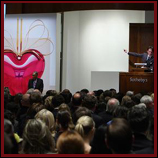 Charity Auction
Charity Auction
Sometime next year, the 20 million year old “Crown Jewel of the Sea” naturally heart shaped fossil coral and red sea glass timepiece described above … and it’s matching naturally heart shaped red sea glass pendant will be auctioned for charity. All of the profits from this auction will be donated directly to the winner’s charity of choice (the winner may choose their own personal charity if they wish).
This is a simple auction. One item. Highest bidder wins. Winning bidder remits auction fees directly to the auction house … and the remainder directly to their chosen charity. Upon verified receipt of funds from their chosen charity … their timepiece and pendant will be delivered anywhere in the world via armoured courier.
The most expensive clock in history (a Breguet) was auctioned by Sotheby’s in 1999 for $5.7 Million … and it was not for charity. Alex contends that the “Crown Jewel of the Sea” timepiece is rarer … not only because it is one of a kind … but more importantly because it cannot be copied or duplicated (replicas of Breguet’s clocks have already found their way into the marketplace). He hopes to raise even more for charity with this auction than what the Breguet clock sold for.
Starting Bid: $1,000,000.00


